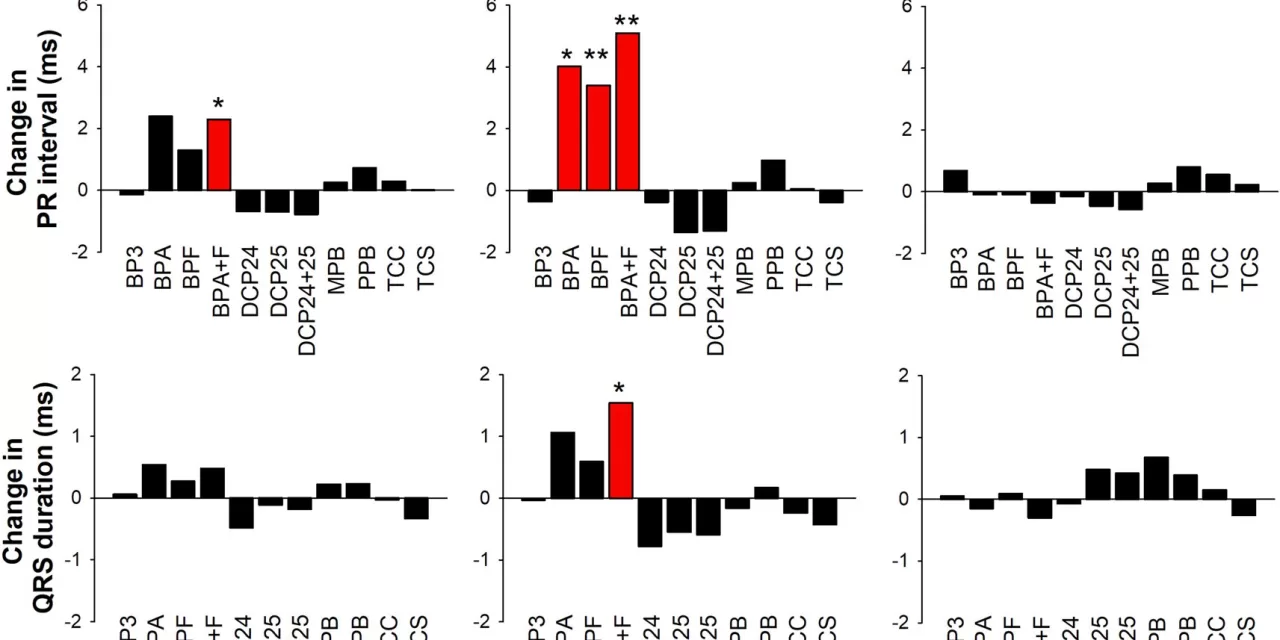A groundbreaking study conducted by researchers at the University of Cincinnati has revealed that exposure to environmental phenols, chemicals found in a variety of everyday consumer products, can have an adverse impact on the heart’s electrical properties. The findings, recently published in the journal Environmental Health, show that certain chemicals commonly used as preservatives, plasticizers, and antimicrobials are associated with changes in cardiac electrical activity, potentially increasing the risk of arrhythmias and other heart-related issues.
Environmental phenols, such as bisphenol A (BPA) used in plastic dishware, parabens in shampoos, and preservatives in packaged foods, are ubiquitous in modern life. Humans are exposed to these chemicals on a daily basis, often unknowingly. While previous studies have hinted at the potential toxic effects of these chemicals on the heart, this new interdisciplinary study is the first to directly examine their influence on cardiac electrical activity in humans.
“This is the first study to look at the impact of phenol exposure on cardiac electrical activity in humans,” said Dr. Hong-Sheng Wang, lead author of the study and professor in the Department of Pharmacology, Physiology, and Neurobiology at the University of Cincinnati College of Medicine.
Data from Fernald Community Cohort
The research team utilized data from the Fernald Community Cohort, which consists of nearly 10,000 individuals who lived near the former U.S. Department of Energy uranium processing site in Fernald, Ohio. Participants in this cohort were part of the Fernald Medical Monitoring Program between 1990 and 2008, providing the researchers with a wealth of biological samples and medical records.
Importantly, the study controlled for uranium exposure, making the findings more broadly applicable to the general population. Researchers analyzed urine samples and electrocardiograms (EKGs) collected from participants on the same day to study the effects of environmental phenols on cardiac electrical function.
Sex-Specific Findings on Heart Function
One of the key objectives of the study was to identify any changes in EKG parameters—such as heart rhythm, conduction times, and electrical recharging of the heart—associated with phenol exposure. The heart’s electrical activity is crucial for maintaining normal rhythm, and disruptions can lead to serious conditions such as arrhythmias.
The study found that higher exposure to bisphenols like BPA, BPF, and a combination of BPA and BPF in women was associated with a longer PR interval, a measure of the time it takes for electrical signals to move from the heart’s upper chambers (atria) to the lower chambers (ventricles). Women with higher body mass indexes (BMI) showed even more pronounced electrical delays.
Additionally, women exposed to these chemicals experienced longer QRS durations, indicating potential problems with the contraction of the heart’s ventricles. Dr. Wang highlighted that these changes, while moderate, could exacerbate pre-existing conditions such as heart disease or arrhythmias in vulnerable populations.
For men, the researchers discovered that higher exposure to triclocarban (TCC), an antimicrobial agent formerly used in personal care products and now banned in the U.S., led to a longer QT interval. This means that the heart’s electrical system takes too long to recharge, which can predispose individuals to life-threatening arrhythmias.
Health Implications
Although the study did not observe dramatic changes in heart function in healthy individuals, Dr. Wang noted that the findings are significant for subpopulations at higher risk, such as older adults or those with pre-existing heart conditions. “These were not dramatic changes that we observed, but moderate changes to cardiac electrical activity,” Wang explained. “However, they were particularly pronounced in certain subpopulations.”
The researchers emphasize that while typical exposure levels to these chemicals may not cause immediate clinical harm in healthy individuals, they could worsen cardiac issues in susceptible people, particularly those already predisposed to heart disease or arrhythmias.
Looking forward, the study suggests that future research should focus on newer environmental chemicals and their potential effects on individuals with pre-existing heart conditions.
Interdisciplinary Collaboration
The study was a collaborative effort, with contributions from experts in several fields, including Dr. Susan Pinney, professor of epidemiology, Dr. Jack Rubinstein, professor of clinical cardiology, and Dr. Changchun Xie, professor of biostatistics. Their interdisciplinary approach was key to uncovering the subtle yet important effects of environmental phenols on the heart.
As our understanding of the health impacts of common consumer chemicals grows, this research underscores the importance of re-evaluating daily exposure levels and their long-term effects on human health, particularly heart function.
More Information:
Jack Rubinstein et al, “Association of same-day urinary phenol levels and cardiac electrical alterations: analysis of the Fernald Community Cohort,” Environmental Health (2024). DOI: 10.1186/s12940-024-01114-x











